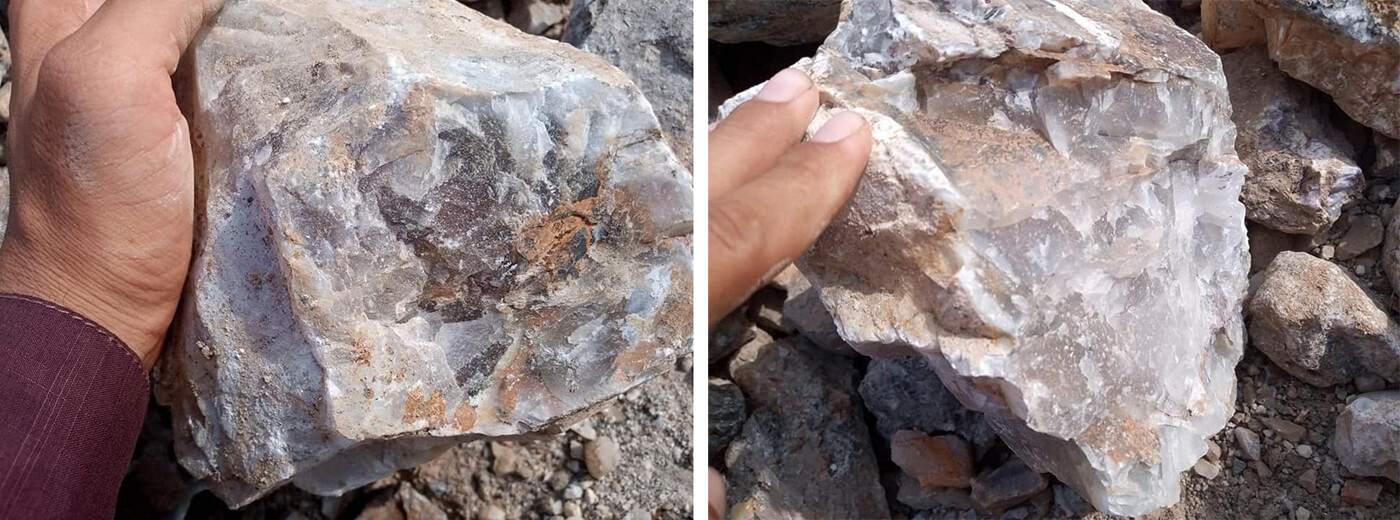How to Conduct Fluorite Flotation for Different Types of Fluorite Rock Ore?
At present, the beneficiation of fluorite rock ore mainly involves three methods: manual selection, gravity (jigging) beneficiation, and fluorite flotation. With the dwindling reserves of fluorite ore and the complex inter – embedding of the fluorite mineral and gangue, fluorite flotation has become the dominant method for separating fluorite from gangue minerals. Based on the different gangue minerals present, fluorite ore can be classified into quartz – fluorite type ore, calcite – fluorite type ore, sulfide fluorite type ore, and barite – fluorite type ore.
Let’s explore the fluorite flotation processes of these different types of fluorite rock ore in detail.

fluorite rock
Quartz–fluorite type ore fluorite flotation process
Quartz-type fluorite ore mainly consists of fluorite (up to about 85% content) and quartz, along with a small amount of calcite, barite, and sulfide. In production, the quartz-fluorite type ore typically undergoes a process of single – stage grinding and roughing, followed by re-grinding the coarse concentrate for multiple selections. The chemical system commonly uses sodium carbonate as a regulator to make the environment alkaline, preventing the excessive activation of quartz by multivalent cations. When fatty acids are used as collectors, an appropriate amount of water glass is added to inhibit silicate gangue minerals.
Based on the characteristics of useful mineral intercalation, quartz – fluorite type ore can be divided into coarse-grained and fine-grained intercalation types. Coarse – grained embedded ores use fatty acid collectors, with sodium carbonate as the slurry regulator and water glass as the quartz inhibitor. High – quality fluorite concentrate can be obtained through a coarse and multi – precision process. For fine – grained embedded ore, although the fluorite flotation reagents are the same, intensified grinding is needed due to the finer particle size, and a stage-grinding and stage – separation process is adopted.
Calcite – fluorite type ore fluorite flotation process
The main components of calcite – fluorite type ore are fluorite and calcite (more than 30% content), sometimes with a small amount of quartz, and it can even form quartz – calcite – fluorite type ore, which is a refractory ore. The difficulty in separating this type of ore lies in the fact that both calcite and fluorite are calcium – containing minerals with similar surface properties, leading to mineral interconversion in solution. Selecting the right collectors and inhibitors is crucial for separating fluorite from calcite. Adjusting the pH of the slurry and combining with the right collector can achieve good separation. When the pH is 8 – 9.5, water glass, acidified water glass, etc. can be used alone or in combination to inhibit calcite.
Flotation process of sulfide fluorite type ore
In actual production, the beneficiation of sulfide fluorite – type ore mainly relies on fluorite flotation. First, the sulfide ore is floated using xanthate collectors, and then the tailings are treated as fluorite ore and selected multiple times with fatty acid agents. Sometimes, a small amount of sulfide ore inhibitor like cyanide is added during fluorite flotation to ensure the quality of the fluorite concentrate.
Flotation process of barite – fluorite type ore
The main minerals in barite – type fluorite rock ore are barite and fluorite. The beneficiation usually involves mixed flotation to get a barite – fluorite mixed concentrate, and then separation. There are two separation methods. One is to inhibit barite for fluorite flotation, obtaining high – grade barite and fluorite concentrates. The other is to inhibit fluorite for barite flotation, which is simpler but may result in lower – grade fluorite. In actual production, the fluorite-inhibiting-barite process is often used, with fatty acid flotation agents as fluorite collectors and a combination of organic and inorganic inhibitors.
The flotation reagent system and grinding fineness are crucial in the fluorite flotation process. Don’t make hasty decisions. Conduct a beneficiation test first. Understand the ore nature, consider the plant’s actual situation and investment budget, and then determine the best fluorite flotation process and reagent system. Let’s take action now to ensure efficient and cost – effective fluorite mineral processing!
Whatsapp:+86 133 1927 7356
Email:[email protected]

